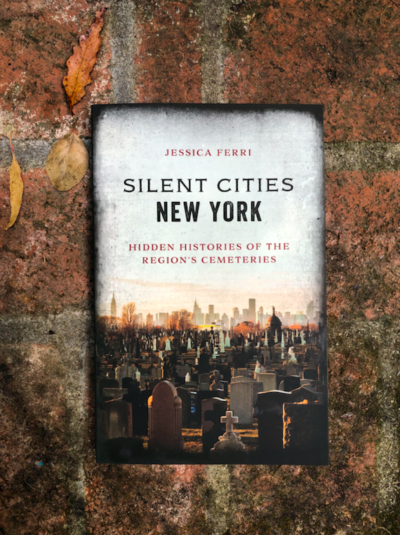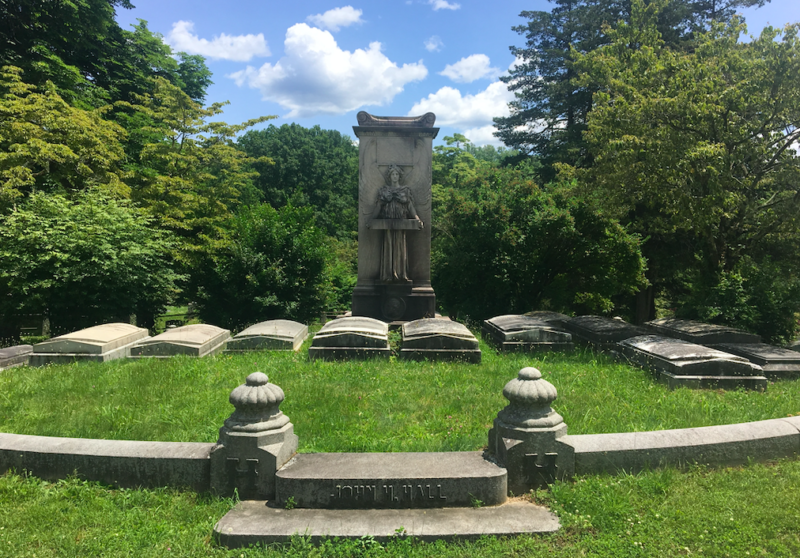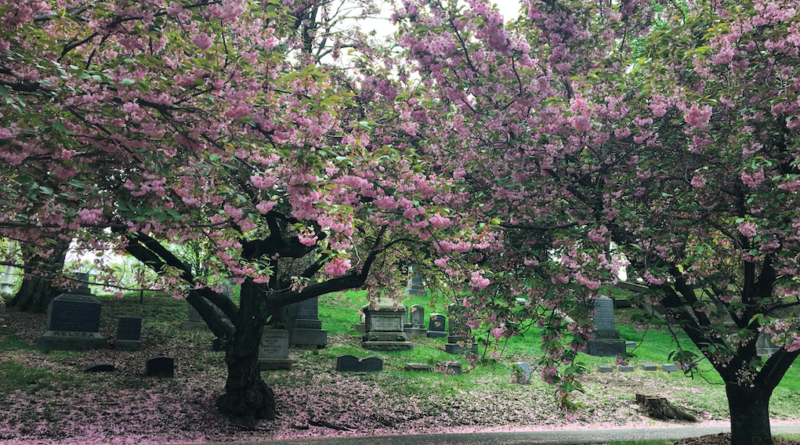INTERVIEW: NY cemetery stories come alive in Jessica Ferri’s new book of ‘hidden histories’
Photo: Jessica Ferri’s new book Silent Cities New York features a chapter on Green-Wood Cemetery in Brooklyn. Photo courtesy of Jessica Ferri / Provided with permission.
If one walks through Green-Wood Cemetery during the warmer months, an abundance of spring flowering is apparent along every turn of this South Brooklyn historic site. Whether climbing a small hill to find composer Leonard Bernstein’s grave or searching out the simple headstone of artist Jean-Michel Basquiat, the reflection-filled adventures in this park cemetery are numerous and could easily fill an entire day on a traveler’s calendar. The monk parakeets that fly throughout the gardens and nest within the cornices of Green-Wood’s entrance gate seem a pleasant and wholly appropriate complement to a sunny day’s wanderings.
Jessica Ferri, a noted writer and journalist, has been entranced by Green-Wood and other cemeteries in New York and around the world for quite some time. The fascination with these final resting places has been with her since childhood, and they inspired her to take pictures of the most characteristic and most interesting of graves on her journeying. That led to a successful Instagram account, and now those pictures and stories have led to the publication of Silent Cities New York: Hidden Histories of the Region’s Cemeteries, available now from Globe Pequot.
“I have always been interested in cemeteries, even as a young child, which I write about in the book,” Ferri said in a recent phone interview. “I was always curious about the people who were there and wanted to know more, but there was always this stigma. I always got the idea that the adults present didn’t want us wandering around in the cemetery.”
Ferri said she has always been fascinated by the unique way in which cemeteries can tell stories. During her days in middle school and high school, she would scope out cemeteries while traveling with her family. Then, as an adult, her fascination came more into focus during a trip to Hong Kong with her husband.
“We were there because my husband was going to a conference in mainland China, and I had a whole day basically where I was alone,” she said. “I was by myself in Hong Kong, and I had read about the cemetery there in the city but obviously had never been. So I walked from our hotel to this incredible cemetery, which is in the city center of Hong Kong, which is just an incredible sight because you’re obviously surrounded by huge skyscrapers and apartment buildings. Then at the foot of the mountains you have what could only be described as a crater. It’s sort of terraced, so it’s built up from a much lower level in the city. And then as time went on, they would build layer upon layer, so you sort of walk not knowing where you’re going. There’s this huge set of stairs, and you walk up this ginormous, very steep incline. When you get to the top, you look down, and it’s just thousands and thousands of headstones.”
In that moment, looking down upon the thousands of headstones in Hong Kong, she realized a great project could be developed on the historic intricacies of cemeteries around the world. She set out to understand the backgrounds of these “silent cities,” which eventually became the namesake of her Instagram account. Those photos led to a book deal, and the book may lead to a television show that explores these architectural wonders.
“The thing about writing about cemeteries is that there are a great number of excellent guidebooks, so there is a lot that has been written about cemeteries and mostly through their select graves or ‘notable’ graves,” Ferri said. “But to me that was only one way of understanding cemeteries. That’s one way in, which is most people’s way in, which there’s nothing wrong with that. It’s completely normal to want to visit the graves of celebrities or writers or artists or people who have meant something to you in your life, but there’s less written about the connection between the history of a place and the development of the city and that connection to cemeteries.”
Silent Cities New York is a combination of the deeply personal and the engagingly historical. There are stories of Ferri’s own wanderings around these places of rest, and then there are stories of individuals, representative of the times they lived in, and how they ended up owning a family plot in these carefully chosen locations in New York. Throughout the book she explores from Mount Zion Cemetery in Queens to Green River Cemetery in East Hampton, and everywhere in between. She sets aside a whole chapter for Sleepy Hollow Cemetery in Tarrytown and another one for Hartsdale Pet Cemetery in Hartsdale. Filling in the historical blanks for each of these places was archival information and talks with a variety of experts.
“I visited lots of archives in order to do research on the more nitty-gritty historical details of the book,” said Ferri, whose work has been published by The New Yorker’s Page Turner blog, The Economist and NPR, among other outlets. “Obviously the New York Public Library has a huge archive, and I spoke to people who worked at the cemeteries themselves. Some of the more historical, like the landmarked cemeteries like Green-Wood and Woodlawn in the Bronx, they have appointed historians, so those people are obviously a huge help.”

There were many obstacles along the way. For example, if a family’s plot is still active and one day may welcome future family members, then privacy rules take over, and access is typically restricted. The older graveyards are easier to find information on, especially when talking about Woodlawn and Green-Wood.
“I was lucky enough to have a great relationship with the president of Ferncliff who was really nice to me and spoke to me openly about the family history behind Ferncliff, which is one of my favorite cemeteries in New York,” Ferri said. “Also the fact that [at] Woodlawn they [granted] all of their records to the Avery [Architectural & Fine Arts] Library at Columbia University, so that is amazing for researchers and writers like me that want to take a look at those records. You just don’t have that with most cemeteries. Most cemeteries keep the records on site. There are things that you can learn about the development of the cemetery, like at the Brooklyn Historical Society about the development of Green-Wood and who’s responsible for that and how the cemetery was planned, but there’s less about the internal history of the cemetery itself. And that’s all kept at Green-Wood, and you have to apply to be able to access that information whereas with Woodlawn because it’s at Columbia, if you’re a researcher, you can apply and go in and see these incredible records, which they have on every lot. So it’s something insane like 9 miles of paper or something, but, yeah, it’s an incredible archive that they have at the Avery Library.”
Ferri’s book couldn’t include all of the cemeteries in the New York City region (perhaps a sequel one day?). She said there could be thousands in the metropolitan area, from small ones besides old churches to large ones like the park cemeteries in Queens and Brooklyn. When she was determining the final selection, she had one stipulation in mind.
“Because the nature of the book is travel-oriented, and because it is narrative nonfiction … that immediately narrowed down the chapters,” she said. “One of the reasons why I wrote the book is because I wanted to encourage people to actually visit these places and explore them.”
One cemetery that is not in the book, but has been in the news due to the COVID-19 outbreak, is the large public cemetery on Hart Island, located near City Island in the Bronx. Access to the island is extremely restricted, and so Ferri didn’t think it was a good idea to include the cemetery alongside more easily accessible locations.
“I felt that it would have been frustrating to the reader to speak about a place they we’re legally barred from visiting,” Ferri said. “I wanted to encourage everybody that read the book to go and visit these places, so there were some parameters already in place that were not my choice.”
When writing the book, Ferri would often find herself visiting a cemetery three or four times per week. She said she became “intimately acquainted” with the locations and kept thinking about the best way to interpret their stories in the forthcoming Silent Cities New York. A couple of the featured cemeteries, including Kensico Cemetery in Valhalla, were brand new to her.
“So it was multiple, multiple trips to every cemetery in the book, just to make sure that I had my bases covered,” she said. “It was also the kind of writing that I wanted to do. I wanted it to be really present and feel really personal, and that’s one of my favorite things about the book. I hope that people feel like they’re there and they’re experiencing it in real time. … You could call it armchair travel or travel writing, but it was really important for me to be physically there as much as humanly possible because to me that is what is so wonderful about these places is that all the things that you notice when you’re there.”
Up next for Ferri is a Silent Cities book on San Francisco and the Bay Area, no doubt another area of the country with many hidden histories to tell.
By John Soltes / Publisher / John@HollywoodSoapbox.com
Silent Cities New York: Hidden Histories of the Region’s Cemeteries by Jessica Ferri is now available. Click here for more information. Follow Ferri on Instagram here and Silent Cities on Instagram here.

Revised reference to Green-Wood.

